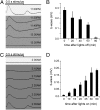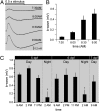Zebrafish larvae lose vision at night
- PMID: 20224035
- PMCID: PMC2851871
- DOI: 10.1073/pnas.0914718107
Zebrafish larvae lose vision at night
Abstract
Darkness serves as a stimulus for vertebrate photoreceptors; they are actively depolarized in the dark and hyperpolarize in the light. Here, we show that larval zebrafish essentially turn off their visual system at night when they are not active. Electroretinograms recorded from larval zebrafish show large differences between day and night; the responses are normal in amplitude throughout the day but are almost absent after several hours of darkness at night. Behavioral testing also shows that larval zebrafish become unresponsive to visual stimuli at night. This phenomenon is largely circadian driven as fish show similar dramatic changes in visual responsiveness when maintained in continuous darkness, although light exposure at night partially restores the responses. Visual responsiveness is decreased at night by at least two mechanisms: photoreceptor outer segment activity decreases and synaptic ribbons in cone pedicles disassemble.
Conflict of interest statement
The authors declare no conflict of interest.
Figures






References
-
- Tomita T. Electrophysiological study of the mechanisms subserving color coding in the fish retina. Cold Spring Harb Symp Quant Biol. 1965;30:559–566. - PubMed
-
- Tomita T. Electrical activity of vertebrate photoreceptors. Q Rev Biophys. 1970;3:179–222. - PubMed
-
- Wangsa-Wirawan ND, Linsenmeier RA. Retinal oxygen: Fundamental and clinical aspects. Arch Ophthalmol. 2003;121:547–557. - PubMed
Publication types
MeSH terms
Grants and funding
LinkOut - more resources
Full Text Sources

